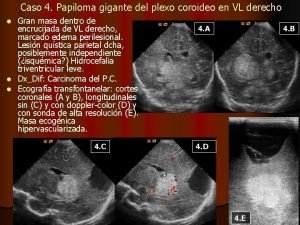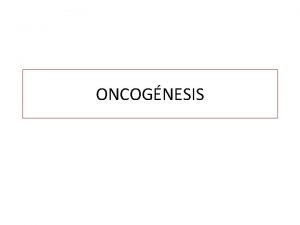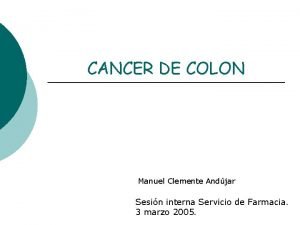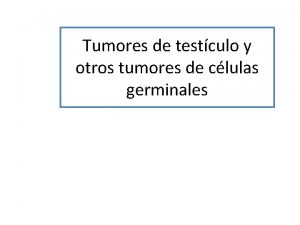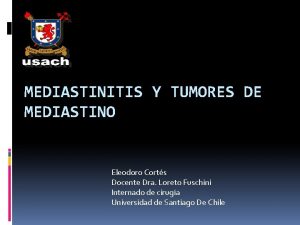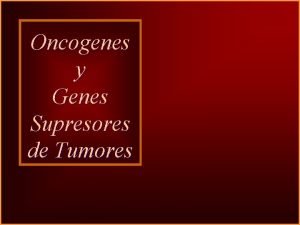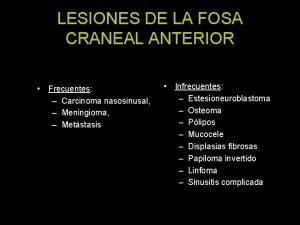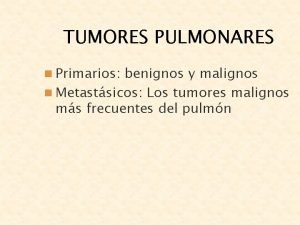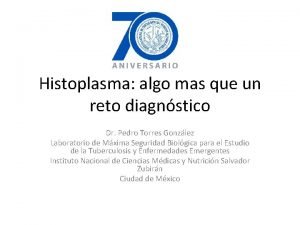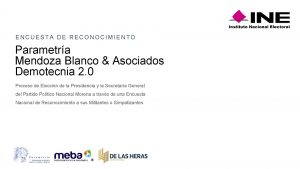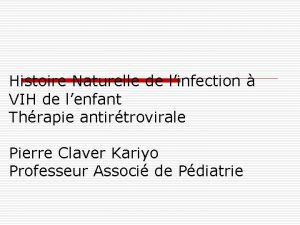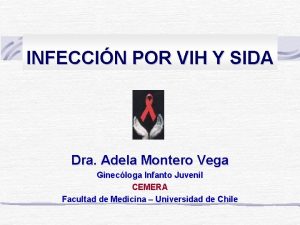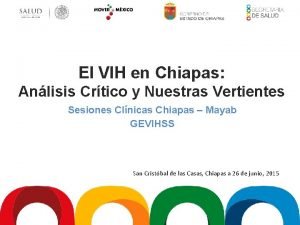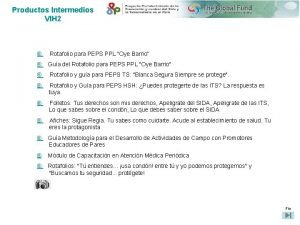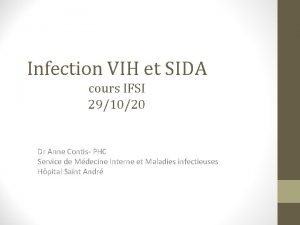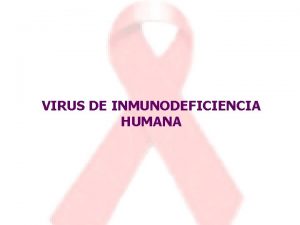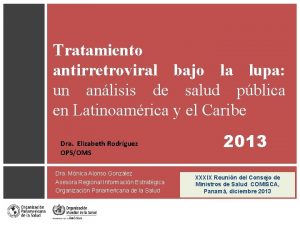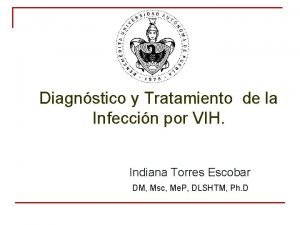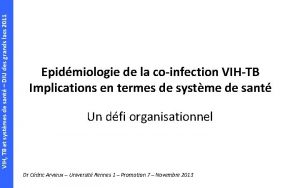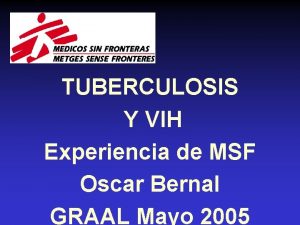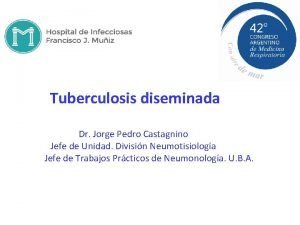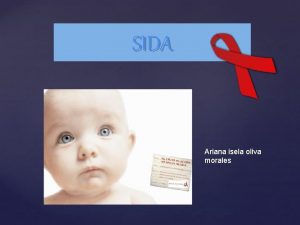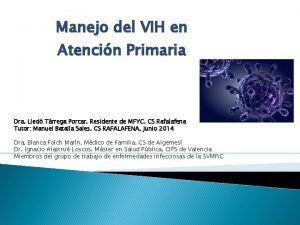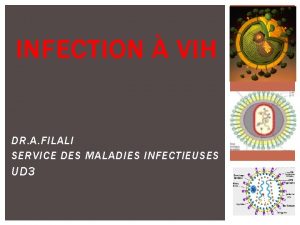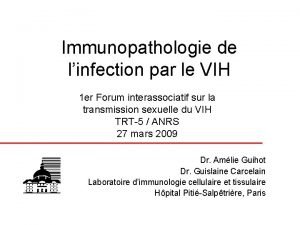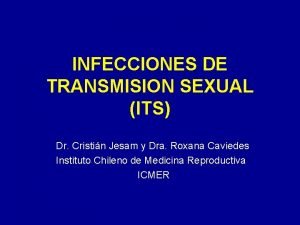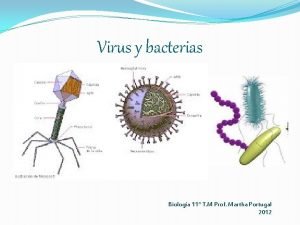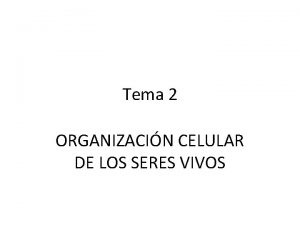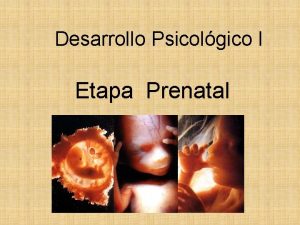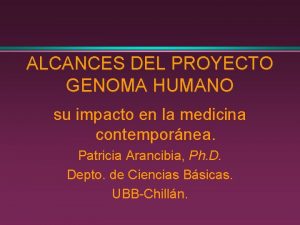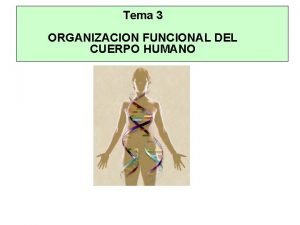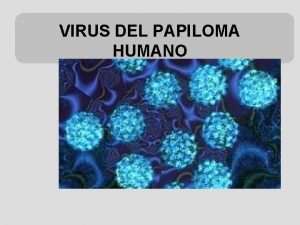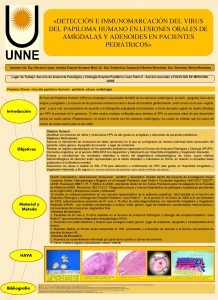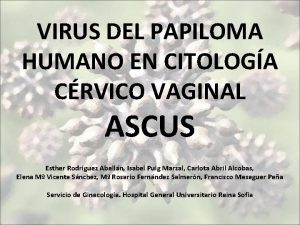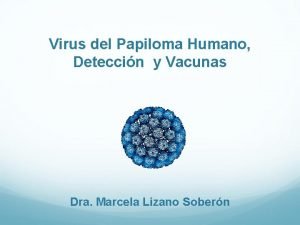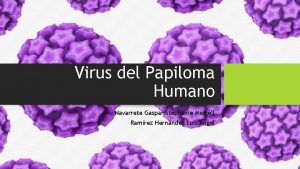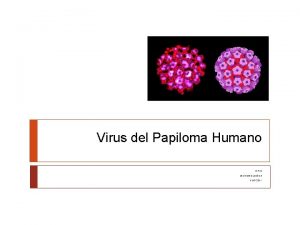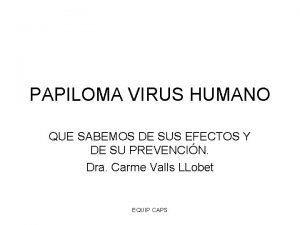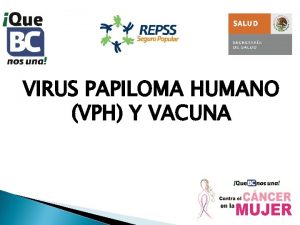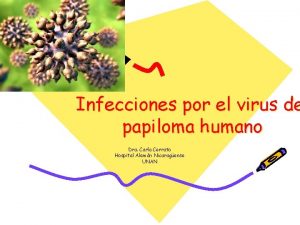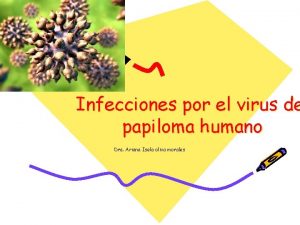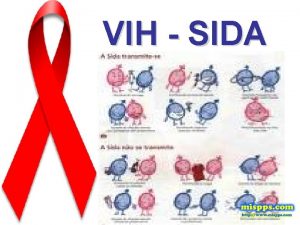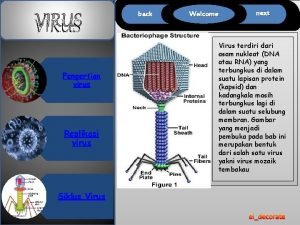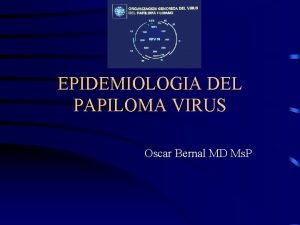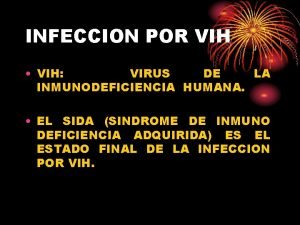Virus del papiloma humano VIH y tumores asociados

















































































- Slides: 81

Virus del papiloma humano, VIH y tumores asociados Dr. Guillem Sirera H. Germans Trias i Pujol Badalona, Barcelona


VIH – VPH Investigación clínica - Unidad VIH HUGTP (Badalona)











Cohorte vella Características basales • 1997 – 2006 • 296 mujeres VIH-positivas • No antecedentes de patología cervical • Edad: 35 (7) [20 -64] • Tiempo de infección por VIH: 6 (5) • TARGA previo: 35% • CV (copias/m. L): • CD 4 basal (cél/µL): • CD 4 nadir (<200 cél/µL): 55055 (146710) 283 (157) 34%

HPV – epidemiology Natural History (cervix) 1 st infection persistent infection 2 on pre-cancerous lesions 3 rd cancer

HIV / HPV-infection 1 st, HPV-infection ¿ cuál es la prevalencia de infección cervical por HPV en mujeres VIHpositivo, • sin antecedentes de patología cervical, y • 2 citologías consecutivas normales?

HIV / HPV-infection 1 st, HPV-infection Prevalence m. PCR HC-2 63% 41% 95%CI: 53%-73% 95%CI: 31%-51% 21% infection by only 1 HPV 42% multiple HPV infection Sirera et al. Med Clin 2005. Videla et al JAIDS 2009.

HIV / HPV-infection 1 st, HPV-infection Prevalence HPV-type % 95%CI 16 28 19 -37 33 18 10 -26 52 12 5 -19 39 11 5 -17 58 11 5 -17 68 10 4 -16 18 8 2 -14 51, 59, 35, 56, 45 <6 6 5 1 -9 11 1 0 -3 Videla et al JAIDS 2009.

Mujer ‘tipo’ VIH+ (cérvix): Infección por VPH: • 3 de cada 5 infectadas (60%) por el VPH • 2 de cada 5 infectadas (40%) por múltiples VPH

HIV / HPV-infection 1 st, HPV-infection ¿ cuál es la persistencia de infección cervical por HPV en mujeres VIHpositivo, • sin antecedentes de patología cervical y • 2 citologías consecutivas normales? Videla et al JAIDS 2009.

HIV / HPV-infection 1 st, HPV-infection Persistence* m. PCR HC-2 86% 95%CI: 77%-95% 76% 95%CI: 62%-90% *mean 20 months; range 6 -44 months after baseline > 80% a los 3 años Videla et al JAIDS 2009.

Mujer ‘tipo’ VIH+ (cérvix): Infección por VPH: • 3 de cada 5 infectadas (60%) por el VPH • 2 de cada 5 infectadas (40%) por múltiples VPH • La infección persiste durante al menos 3 años en 4 de cada 5 mujeres infectadas (80%)

HIV / HPV-infection 1 st, HPV-infection ¿ cuál es la aclaramiento de infección cervical por HPV en mujeres VIHpositivo, • • • sin antecedentes de patología cervical, con 2 citologías consecutivas normales, y con infección por VPH ?

HIV / HPV-infection 1 st, HPV-infection Clearance m. PCR HC-2 14% 24% 95%CI: 5%-23% Actuarial probability at 36 months: 16% Videla et al JAIDS 2009. 95%CI: 10%-38%

Mujer ‘tipo’ VIH+ (cérvix): • • Infección por VPH: 3 de cada 5 infectadas (60%) por el VPH 2 de cada 5 infectadas (40%) por múltiples VPH La infección persiste durante al menos 3 años en 4 de cada 5 infectadas (80%) La infección por el VPH se ‘auto’ elimina a los 3 años en 1 de cada 5 infectadas (20%)

HIV / HPV-infection 1 st, HPV-infection ¿ cuál es la incidencia de infección cervical por HPV en mujeres VIHpositivo, • sin antecedentes de patología cervical, • 2 citologías consecutivas normales, • y sin infección por VPH ?

HIV / HPV-infection 1 st, HPV-infection Incidence m. PCR HC-2 18% 27% 95%CI: 5%-31% Actuarial probability at 36 months: 45% Videla et al JAIDS 2009. 95%CI: 15%-39%

Mujer ‘tipo’ VIH+ (cérvix): • • • Infección por VPH: 3 de cada 5 infectadas (60%) por el VPH 2 de cada 5 infectadas (40%) por múltiples VPH La infección persiste durante al menos 3 años en 4 de cada 5 infectadas (80%) La infección se ‘auto’ elimina a los 3 años en 1 de cada 5 infectadas (20%) 2 de cada 5 pacientes se infectarán antes de los 3 años

HPV – epidemiology Natural History (cervix) 1 st infection persistent infection 2 on pre-cancerous lesions 3 rd cancer

HIV / HPV-precancer lesions 2 nd Cervical Intraepitelial Neoplasia ¿ cuál es la prevalencia de lesiones pre -cancerosas por HPV mujeres VIHpositivo, • sin antecedentes de patología cervical ?

HIV / HPV-precancer lesions 2 nd Cervical Intraepitelial Neoplasia Prevalence (%) 25% L-SIL 7% H-SIL 32% (24%-40%) Sirera et al. Med Clin 2005; 125: 127 -131.

Mujer ‘tipo’ VIH+ (cérvix): • • • Infección por VPH: 3 de cada 5 infectadas (60%) por el VPH 2 de cada 5 infectadas (40%) por múltiples VPH La infección persiste durante al menos 3 años en 4 de cada 5 infectadas (80%) La infección se ‘auto’ elimina a los 3 años en 1 de cada 5 infectadas (20%) 2 de cada 5 pacientes se infectarán antes de los 3 años Lesiones pre-cancerosas: • 1 de cada 3 (32%) presentan lesiones pre-c

HIV / HPV-precancer lesions ¿ cuál es la incidencia de lesiones precancerosas por HPV en mujeres VIH -positivo, • • • sin antecedentes de patología cervical, 2 citologías consecutivas basales normales, y tratadas con TARGA en el seguimiento (entre citologías) ? Sirera et al. AIDS Res Hum Retrov 2007

HIV / HPV-precancer lesions Probability of remaining free of SIL 1, 0 0, 8 0, 6 0, 4 0, 2 1 2 years 0, 0 0 500 28% 3 1000 4 1500 42% 5 2000 6 2500 48% Sirera et al. AIDS Res Hum Retrov 2007 7 3000 52% days Probability of SIL

HIV / HPV ¿ cuál es la incidencia de lesiones precancerosas por HPV en mujeres VIHpositivo, • sin antecedentes de patología cervical, • 2 citologías consecutivas normales, • y tratadas con TARGA en el seguimiento (entre citologías) según su estado inmunológico ? Sirera et al. AIDS Res Hum Retrov 2007

HIV / HPV Probability of remaining free of SIL depending on immunological status probability of remaining free of SIL 1, 0 Panel A log rank, p=0. 012 0, 8 0, 6 0, 4 0, 2 0, 0 0 500 1000 ≤ 200 / ≤ 200 CD 4 censored ≤ 200 / >200 CD 4 censored >200 / >200 CD 4 censored 1500 2000 Sirera et al. AIDS Res Hum Retrov 2007 2500 3000 days

HIV / HPV ¿ cuál es la incidencia de lesiones precancerosas por HPV en mujeres VIH -positivo, • sin antecedentes de patología cervical, • 2 citologías consecutivas basales normales y • tratadas con TARGA en el seguimiento (entre citologías) según la carga viral del VIH ? Sirera et al. AIDS Res Hum Retrov 2007

HIV / HPV Probability of remaining free of SIL depending on viral load probability of remaining free of SIL 1, 0 0, 8 0, 6 0, 4 0, 2 0, 0 0 500 1000 ≤ 50 / ≤ 50 HIV copies censored ≤ 50 / >50 HIV copies censored >50 / ≤ 50 HIV copies censored >50 / >50 HIV copies censored 1500 2000 Sirera et al. AIDS Res Hum Retrov 2007 2500 3000 days

HIV / HPV ¿ cuál es la incidencia de lesiones precancerosas por HPV en mujeres VIH -positivo, • sin antecedentes de patología cervical, • 2 citologías consecutivas basales normales y • según su estado inmunológico (>350 CD 4) ? Sirera et al. JAC 2007

HIV / HPV Effect of HAART when the immunological status is above 350 CD 4 Actuarial probability at 3 years: • HAART: 70% • No-HAART: 78% Sirera et al. JAC 2007

Mujer ‘tipo’ VIH+ (cérvix): • • • Infección por VPH: 3 de cada 5 infectadas (60%) por el VPH 2 de cada 5 infectadas (40%) por múltiples VPH La infección persiste durante al menos 3 años en 4 de cada 5 infectadas (80%) La infección se ‘auto’ elimina a los 3 años en 1 de cada 5 infectadas (20%) 2 de cada 5 pacientes se infectarán antes de los 3 años Lesiones pre-cancerosas: • 1 de cada 3 (32%) presentan lesiones pre-c • 2 de cada 5 (42%) desarrollarán una lesión preneoplásica antes de los 3 años • TARGA: mantener el estado inmunológico por encima de 350 CD 4 con TARGA

HPV – epidemiology Natural History (cervix) 1 st infection persistent infection 2 on pre-cancerous lesions 3 rd cancer

Prevalence Infection 63% 95%CI: Pre-cancerous lesions 32% 53%-73% 95%CI: 24%-40% Prevalence (%) Cancer ?

HIV / HPV squamous cancer 3 rd, cervical cancer Cáncer de cérvix en España (AECC, ine): Prevalencia: 7, 6 casos / 100000 habitantes / año • Baja prevalencia 600 fallecimientos anuales (HIV ? ): • >80% no controles ginecológicos

Cohorte “cáncer de cérvix” Características basales • 1997 – 2009 (retrospectiva) • 31 mujeres VIH-positivas ◊ 109 VIH-negativas (emparejadas por edad, diagnóstico, hospital) • CIN III o c. invasivo • Edad: 46 [28 -55] HIV-cohorte: • Tiempo de infección por VIH: 15 [1 -22] • TARGA previo: 35% • CD 4 nadir (cél/µL): 99 [1 -780]

HIV / HPV-cancer HPV-type HIV-positive n (%) HIV-negative n (%) OR (95% CI) 16 17 (68) 28 (72) 0. 7 (0. 2 -2 -1) 18 2 (8) 3 (8) 1. 0 (0. 2 -6. 7) 31 2 (8) 1 (3) 3. 3 (0. 3 -38. 5) 33 2 (8) 4 (10) 0. 8 (0. 1 -4. 5) 35 1 (4) 1 (3) 1. 6 (0. 1 -26. 5) 39 nd 2 (5) - 45 nd 1 (3) - 52 2 (8) nd 8. 4 (0. 4 -182. 8) 53 2 (8) nd 8. 4 (0. 4 -182. 8) 58 3 (12) 2 (5) 2. 5 (0. 4 -16. 3) 66 1 (4) nd 4. 8 (0. 2 -123) 6 nd 2 (5) - ≥ 2 types 3 (12) 5 (13) 0. 9 (0. 2 -4. 3) Cañadas et al. Int J Cancer 2009, enviado a publicar.

VPH

2% 16% 45%

Cohorte CARH·MEN Características basales • 2005 – 2009 (inclusión) • 700 hombres VIH-positivos: • 67% homosexuales • 33% heterosexuales • No antecedentes de patología anal • Edad: 44 [38 -49] • Tiempo de infección por VIH: 12 [6 -18] • TARGA previo: • CV (copias/m. L): 96% 50 [50 -420] • CD 4 basal (cél/µL): 469 [298 -643] • CD 4 nadir: 222 [94 -341]

HIV – HPV: anus

HIV / HPV-infection 1 st, HPV-infection ¿ cuál es la prevalencia de infección anal por HPV en • hombres VIH-positivo, • sin antecedentes de patología anal ? Sirera et al. AIDS 2006.

HIV / HPV-infection 1 st, HPV-infection Prevalence m. PCR 78% 95%CI: 72%-83% 21% infection by only 1 HPV 57% multiple HPV infection Cañadas et al. JAIDS 2009. Sirera et al. AIDS 2006.

HIV / HPV-infection 1 st, HPV-infection Anus HPV infection Number of HPV-types per sample MSM Hetero-sexual 83% 68% 1 19% 60% 2 26% 7% 3 23% 13% 4 16% 7% ≥ 5 16% 7% YES Sirera et al. AIDS 2006.

HIV / HPV-infection 1 st, HPV-infection HPV-type Infection Integration 16 29% 9% (95%CI: 23%-34%) (95%CI: 6%-13%) Cañadas et al. JAIDS 2009.

Hombre ‘tipo’ VIH+: Infección anal por VPH: • 4 de cada 5 infectados (78%) por el VPH • 3 de cada 5 infectados (68%) por múltiples VPH • MSM: 4 de cada 5 infectados • Heterosexuales: 2 de cada 3 infectados • 1 de cada 10 tiene integrado el VPH-16 • Similar infección por VPH-16 en ano en hombres (29%) y cérvix (28%)

HIV / HPV-precancer lesions 2 nd Anal Intraepitelial Neoplasia Prevalence 43% 95%CI: ASCUS L-SIL H-SIL 32%-55% 13% 19% 11%

Hombre ‘tipo’ VIH+: Infección anal por VPH: • 4 de cada 5 infectados (78%) por el VPH • 3 de cada 5 infectados (68%) por múltiples VPH • MSM: 4 de cada 5 infectados • Heterosexuales: 2 de cada 3 infectados • 1 de cada 10 tiene integrado el VPH-16 • Similar infección por VPH-16 en ano en hombres (28%) y cérvix (28%) Lesiones pre-cancerosas: • 2 de cada 5 (43%) presentan lesiones pre-c










HIV / HPV anal cancer 3 rd Anal Cancer Rates Prevalence Infection 78% 95%CI: Pre-cancerous lesions 43% Cancer 72%-83% 95%CI: 35%-55% • España: • MSM ‘pre-HIV’: • MSM HIV+: Johnson 2004; Daling 1982; Rabkin 1998. 0. 5/100 000 35/100 000 70/100 000

Anal Human Papillomavirus Type 16 Infection and Its Integration Status by means of A Novel Multiplex Real Time-PCR in Cytological Samples of HIV-Positive Men • M. P. Cañadas 1, 2, L. Darwich 1, 3, S. Videla 4, V. Cirigliano 2, F. Garcia. Cuyas 5, M. Piñol 5, M. Llatjos 6, E. Castella 6, M. Bofill 1, B. Clotet 1, 7, G. Sirera 4, 7 on behalf of the HIV-HPV Can Ruti Study Group. • 48 th ICAAC 2008

- RESULTADOS • 77 pacientes VPH -16 • CITOLOGIA • NORMAL 18 1 • ASCUS 17 3 (18 %) • LSIL 32 • • HSIL 10 -----77 INTEGRADOS (32 %) 14 (44 %) (2 car in situ) 7 (70 %) ----25

RESULTADOS Factores de riesgo para la integración de HPV-16 Descripciónde parametros OR (95% CI) P 1. 069 ( 0. 98 -1. 15) 0. 1 Duracion of HIV infeccion (años) 1. 29 (1. 07 -1. 54) 0. 007 Duracion of HAART (años) 1. 09 ( 0. 91 -1. 3) 0. 3 Comportamiento sexual (HSH si) 4. 4 (1. 03 -18. 5 ) 0. 06 1. 3 (0. 3 -5. 9) 0. 68 Nadir 10. 45 (1. 25 -87. 16) 0. 03 Basal 2. 65 (0. 56 -12. 4 ) 0. 215 3. 13 (0. 63 -15. 5) 1. 56 (0. 3 -7. 2) 0. 16 0. 56 Edad (años) HIV-1 carga viral basal CD 4 cifra células Numero of HPV tipos/muestra 1 HPV (HPV 16 solo) 2 HPV (HPV 16 + otro) ≥ 3 HPV (HPV 16 + otros)

HIV – HPV: penis

HIV / HPV-infection 1 st, HPV-infection ¿ cuál es la prevalencia de infección peneal por HPV en hombres VIHpositivo ?

HIV / HPV-infection 1 st, HPV-infection Prevalence m. PCR 36% 95%CI: 26%-48% 76% infection by only 1 HPV 24% multiple HPV infection Sirera et al. AIDS 2006.

HIV – HPV: oral cavity

HIV / HPV-infection 1 st, HPV-infection ¿ cuál es la prevalencia de infección por HPV en cavidad oral en hombres VIH-positivo ?

HIV / HPV-infection 1 st, HPV-infection Prevalence m. PCR 26% 95%CI: 18%-35% 60% infection by only 1 HPV 40% multiple HPV infection Sirera et al. AIDS 2006. Sirera et al. CROI 2007.

HIV / HPV-infection Prevalence Anal Pene Oral 78% 36% 26% 95%CI: 72%-83% 95%CI: 26%-48% 95%CI: 18%-35% Concomitant HPV infection in 2 o 3 different body parts 46% 95%CI: MSM: 48% 95%CI: 34%-62% 34%-58% Heterosexual: 41% 95%CI: 21%-64%

HIV - HPV FUTURE SCENARIO We have to act as a precaution against possible increase incidence of the HPV-related cancer To push an education program to patients and doctors about HPV and its risk factors To establish programs of screening for all HIV patients: • HPV screening • Cytological screening Because the best treatment of HPV-related cancer is prevention

HIV - HPV PRESENT SCENARIO Cancer HPV-related: Probably increased, but no spectacularly HPV vaccine: ? ? ?


 Metronidazol para que sirve
Metronidazol para que sirve Como se tranmite el sida
Como se tranmite el sida Papiloma plexo coroide
Papiloma plexo coroide Telangiactasia
Telangiactasia Cancer de colon
Cancer de colon Tumores de celulas germinativas
Tumores de celulas germinativas Triada mackler
Triada mackler Tumores benignos de esofago
Tumores benignos de esofago Oncogenes y genes supresores de tumores
Oncogenes y genes supresores de tumores Tumores de fosa anterior
Tumores de fosa anterior Tumores pulmonares benignos
Tumores pulmonares benignos Mitos y realidades del vih
Mitos y realidades del vih Sintomas vih
Sintomas vih Imágenes del vih
Imágenes del vih Estructura organizacional circular
Estructura organizacional circular Riesgos asociados al lavado de activos
Riesgos asociados al lavado de activos Riesgos asociados al lavado de activos
Riesgos asociados al lavado de activos Sip asociados copidrogas
Sip asociados copidrogas Felipe ochoa y asociados
Felipe ochoa y asociados Adgs23exp
Adgs23exp Gestos ilustradores ejemplos
Gestos ilustradores ejemplos Yuxtacrina
Yuxtacrina Mendoza blanco y asociados
Mendoza blanco y asociados Drescher asociados
Drescher asociados Topicos generativos ejemplos
Topicos generativos ejemplos Que numero es
Que numero es Gm asociados
Gm asociados Motonaves aguadulce
Motonaves aguadulce Infectologos asociados
Infectologos asociados Sintomas vih
Sintomas vih Vdrl reactivo tratamiento
Vdrl reactivo tratamiento Classification du vih
Classification du vih Adela montero
Adela montero El vih
El vih Western blot vih
Western blot vih Apeligrate
Apeligrate Prueba elisa vih
Prueba elisa vih Vih cours ifsi
Vih cours ifsi Vih historia
Vih historia Fondos de vih
Fondos de vih Vih historia
Vih historia Vih
Vih Baciloscopia negativa
Baciloscopia negativa Jorge castagnino
Jorge castagnino Vih sida
Vih sida Vih
Vih Cadena epidemiologica de la tuberculosis
Cadena epidemiologica de la tuberculosis Vih
Vih Lymphocyte t
Lymphocyte t Tasa urofecal
Tasa urofecal Dimensiones del desarrollo del niño
Dimensiones del desarrollo del niño Clasificación de las bacterias
Clasificación de las bacterias Imagen de celula eucariota
Imagen de celula eucariota Virus del policia
Virus del policia 9 dimensiones del ser humano
9 dimensiones del ser humano Estructura celular
Estructura celular Sistema seo
Sistema seo Qué es la naturaleza humana
Qué es la naturaleza humana Partes del tronco humano
Partes del tronco humano Incisión paramediana derecha supraumbilical
Incisión paramediana derecha supraumbilical Corte medial del cerebro
Corte medial del cerebro Los cinco sentidos del cuerpo humano
Los cinco sentidos del cuerpo humano Que es la salud para virginia henderson
Que es la salud para virginia henderson Que es la centralidad del ser humano
Que es la centralidad del ser humano Dimensiones del desarrollo humano
Dimensiones del desarrollo humano Etapa prenatal del desarrollo humano
Etapa prenatal del desarrollo humano Virtudes y defectos del ser humano
Virtudes y defectos del ser humano Que es el aspecto conductual
Que es el aspecto conductual El plano transversal
El plano transversal Genoma humano noticia
Genoma humano noticia Niveles de organización funcional del cuerpo humano
Niveles de organización funcional del cuerpo humano Que es la moral del ser humano
Que es la moral del ser humano Definiciones de desarrollo humano
Definiciones de desarrollo humano Sostenibilidad del desarrollo humano
Sostenibilidad del desarrollo humano Progredent
Progredent Historia del proyecto genoma humano
Historia del proyecto genoma humano Etapas del desarrollo del estudiante
Etapas del desarrollo del estudiante Un ser unico e irrepetible
Un ser unico e irrepetible Omoplato
Omoplato 3 sistemas del cuerpo humano
3 sistemas del cuerpo humano Dirección de desarrollo del talento humano en salud
Dirección de desarrollo del talento humano en salud Modelos de comportamiento humano
Modelos de comportamiento humano


